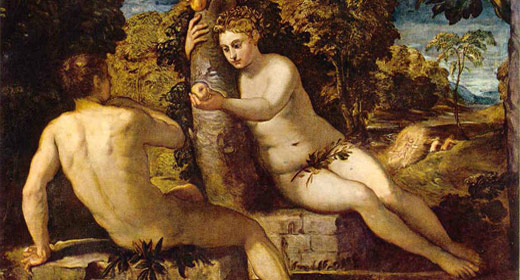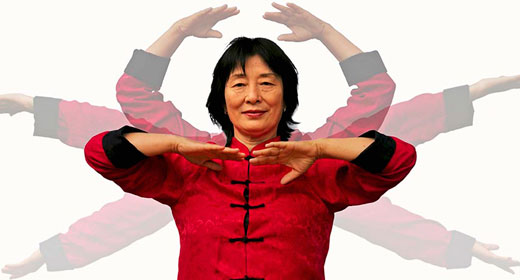by Swami Krishnananda: Though the object of meditation is ultimately everywhere, all pervading…

it is not easy for the mind to fix its attention for a long time on that which is everywhere because never in our daily life do we think that. Things are always somewhere, not in all places. Hence, some concession has to be given to the mind for its usual habits of seeing things only somewhere and not everywhere.
Thus, in the beginning or initial stages of meditation, it is better not to make an attempt at forcing the mind to meditate on that which is everywhere. The mind will find it to be a very hard job.
In our ancient system of yoga we have very interesting techniques of introducing the notion, concept or idea of the universal through particular things. This is a speciality which is especially found in Hinduism. To some extent it is found in other religions also, but not so much as in Hinduism, which has a very large accommodation for every type of approach, for every person, of every age, every qualification, every status, and so on.
The concept of the Universal Almighty cannot be introduced into the limited mind at once, though that is the ultimate aim, so we have to take to very apt methods which are not contrary to the ultimate aim and yet at the same time conducive to the present condition of the mind. Now, this peculiar method of introducing the concept of the universal through the particulars with which alone the mind is usually connected is called the concept of the ishta-devata. This is a Sanskrit word which means ‘chosen deity’. You may ask what is meant by ‘chosen deity’. If there is only one deity, there is no question of choosing, so why do you use such words as ‘chosen deity’, ishta-devata?
When we say ishta-devata, or chosen deity, we do not mean that we are choosing from many deities or many gods. That is a wrong notion. Hindus do not have many gods, but they have many approaches to the one God. So an ishta-devata is not separate from the ultimate deity, but rather one approach to that ultimate deity. So we may say that the ishta-devata is an approach to the ultimate, and is not an independent deity that we are concocting or creating, as if there are really many gods.
Now, the subject of the ishta-devata is very interesting and very important. Perhaps it is indispensable. Just as a Guru is indispensable, an ishta-devata is also indispensable. The ishta-devata becomes indispensable because of the mere fact mentioned in the beginning that the absolute universal cannot be conceived by the mind, and any attempt at it would be a failure.. Only very advanced souls can conceive the universal as it is, and nobody can regard oneself as very advanced in this path.
The ishta-devata, or the deity, does not necessarily mean a person. We have suddenly and immediately introduced into our mind the idea of a personality the moment we think of a deity. That is because we always think in terms of personalities. Every day we think of many persons, so when we think of God also, we think of a person. A chosen deity is a person, and so on, though the deity is not a person in sense of a human being or anything akin to a human being – not a personality, not an individual. Though the chosen deity, the ishta-devata, need not necessarily be conceived as a human individual or anything like the human individual, there is no harm even if the ishta-devata is conceived as something similar to an individual because of the fact that the mind is used to thinking in such a manner. Most people, and all religions perhaps, imagine God as some sort of a personality. Though they philosophically admit that God is not a personality, they cannot think of Him in any other manner than as a large personality, a magnified being. This is adopted and accepted in every religion of the world except Buddhism and Jainism, where the method is a little different. We shall not touch it just now.
Hence, the concept of the ishta-devata is a necessity on account of the very structure of the mind. It is the demand of the mind itself, and it cannot get on without it. It is connected with the nature of the mind, the very way of its thinking. In meditation, we have always to give concession to the habitual predilections of the mind. The weaknesses of the mind have to be taken notice of, and though a weakness is something to be got rid of, we will realise that no weakness can be got rid of at once. It is impossible. So it is no use merely condemning a person for his weakness. Everyone has some weakness, and every weakness has to be removed, no doubt, but not at once because it is a very gradual process like the organic growth of a body or a plant or tree. Very slowly everything is done. We get rid of the weaknesses of childhood not abruptly, but very gradually. We have got rid of all those weaknesses of children, but have we done it in one day? Many months and years have been taken for this purpose. A small plant which we can brush with our foot has become a huge tree which cannot easily be cut even with an axe, but how much time has it taken to become that? Likewise, we should not be in a hurry in anything which is important, whether it is in ordinary life or in spiritual life. Do not be in a hurry for anything. Take things easily, though they may be taken very firmly.
The notion, the idea, the concept of the Absolute Supreme Being is the ultimate goal of meditation, on which the mind has to be fixed finally. You have to meditate on the Ultimate Reality as it is. How will you do it? You have to do it through the form or the shape which the relation between you and the Absolute has taken at the present time. What is the relation between you and the Absolute? Do not say you are the Absolute. You cannot think like that, you cannot feel like that, and you do not act like that. In all of your conduct, you are contradicting this philosophical dissertation of the absoluteness of God because you always feel that you are separate.
Now, the moment you feel you are separate, you establish a kind of relationship because there is a connection between two separate things. At present we are concerned with human beings, or the human individual, and God. What is the connection between you and God, the individual and the Supreme Being? The connection is the idea that the human mind has of that Ultimate Reality. That itself is the connection. You have some idea about it. In spite of the fact that your idea of it may not be clear, you have a notion in your mind that it exists, or at least that it must exist, and there is some sort of an internal relationship between you and that. Because we like concrete things much more than mere abstract notions and concepts, to make it a little more concrete, conceivable and acceptable to the present state of our minds, we introduce the concept of the ishta-devata, the God who presides over our entire life. That is the ishta-devata.
What kind of presiding deity is this? How is this being done? How are we to have a notion of it or conceive it in our minds? This again is a question of initiation. When you are initiated by a Guru, you will be told some details as to how you have to conceive this object of meditation. Now I am giving only a general outline of it, not an initiation, which is the work of a Guru in respect of a disciple.
How does the concept of a particular deity, or an ishta-devata, help in ultimately reaching the universal? How can one thing on which you are meditating lead to the achievement of everything, which is the All-Pervading Being? This is the peculiarity of the philosophy behind this meditational technique. Every particular is connected with the universal. These are the things which you learned from what I told you already. Every individual is connected with the universal in some way or the other. There is no one who is not connected with it, inasmuch as it is an indivisible substance. Every particular thing in the world – organic, inorganic, living, dead, whatever it is – must be connected with it in some way or the other. Whether you are able to conceive this relation or not, the relation must exist. The very acceptance of the fact that the Supreme Being is universal implies that every individual and every particular thing in the world is connected with it. Otherwise, it would not be universal.
In what way is it connected? I am answering the question of how a particular can lead to the universal, how the particular is connected to the universal. Is it connected as things are connected with one another by a link of an iron chain? Is it connected in the way a door is fastened with hinges to the wooden frame? Is it connected in the sense of a relationship between father and son? What is the connection between the particular and the universal? We are to clarify the idea of the connection, and that will give you great satisfaction because otherwise, you will be worried, and it is this worry in the mind that compels it to jump from one thing to another in meditation.
Why does the mind jump in meditation? It is because it has no clear idea of the relationship between this ishta-devata on which it is meditating and the Ultimate Reality. It has no proper notion about it. The mind always thinks there are many things. Even if there is an acceptable ishta-devatabefore me, there are other devatas also. If Rama is my object of meditation and Krishna also is there, the mind will jump to Krishna, and from Krishna it will go to Jesus, and from Jesus to Devi, because it has a peculiar notion that there are many things. In spite of being repeatedly told again and again that ultimately there is only one thing, it will not listen so easily.
The connection between your ishta-devata and the ultimate universal Reality is not like ordinary connections of father and son, mother and child, officer and subordinate, etc. It is an inseparable relationship. You will be able to appreciate how it is inseparable if you understand how an indivisible thing can be connected with anything. Just imagine for a few moments what an indivisible thing could be. We have been discussing the indivisibility of Godhead during the previous few days. Indivisibility means nothing can exist outside it. That is the meaning of indivisibility. If you are somehow imagining that something can exist outside it, then the idea of connection comes; otherwise, how can there be a connection? There is no ordinary connection between the ishta-devata and the universal. It is an extraordinary relationship. What is this extraordinary nature of the relationship?
If the Supreme Being is indivisible and if, therefore, as a consequence thereof, nothing external to it can exist, your ishta-devata cannot exist outside it. So it follows from this that the ishta-devata that you are meditating upon is not outside that universal. “Then is it inside the universal?” you may ask me. This idea of outside and inside does not leave us because we are always thinking in terms of these ideas of externality, internality, etc. The moment we think of inside, we think of inside a room or some such thing. The universal is not like a container or a huge basket inside which the ishta-devata is sitting, nor is it possible for the ishta-devata to exist outside the universal. The ishta-devatais neither inside nor outside the universal because the universal cannot have an inside or outside. The moment there is an inside or outside, it ceases to be universal. The universal is indivisible.
So the ishta-devata, the object of your meditation, is the universal itself which you are conceiving in a partial manner due to the incapacity of your mind. If you are unable to see the entire body of a person and are able to see only a part of it, you could mistake this for the entire person. Or you can deliberately conceive it as the entire person, purposely, with an intention behind it. You can reach the Atlantic or the Pacific through the Ganga. If you take a boat from here, you will be taken to the ocean even though it is so far off. If you sit in a boat on the Yamuna, you will also be taken to the ocean. If you sit in a boat on the Amazon, you will also be taken to the ocean. Any river can take you to the ocean, where all the rivers commingle. So whatever be your idea of God, you will be taken to the ultimate God. You may be a Christian, you may be a Hindu, you may be a Muslim; it makes no difference. Your God and my God are not two Gods. All these gods of religions are like various passages leading to the ultimate ocean of the one Godhead, which is inconceivable, and so we take recourse to all these particular concepts.
So when you meditate on the ishta-devata, or your concept of God, you should invoke upon this concept all the characteristics of the ocean so that you may not forget the inseparability of the ishta-devata from God. This little thing that you are conceiving in your mind, this little personality of Krishna, Rama, Devi, Jesus, whatever it is, which is spatially so small and temporally defined, that small thing can take you to the Absolute in the same way as a small boat in the Ganga can take you to the big Pacific Ocean. It will meander this way and that way, and take you to the Pacific. You may belong to any category of faith or religion, and there is no necessity to change religions. Why do people change their faiths? It is unnecessary. It is due to a kind of misconception about their own religion. Any religion is all right, provided it has a proper idea about the ultimate goal of human life.
We invoke the characteristics of the Supreme Reality on our concept of the ishta-devata. What are the characteristics, and what is meant by ‘invocation’? A number is printed on a dollar note, a small piece of paper – one figure; that is all. You have invoked the idea of a tremendous economic value upon this little scrap of paper, and only then has it become $100. It is only a piece of paper, and merely because 100 is written there, you say it is 100. It can be 1000, or anything. There is nothing in that paper; it can be burned by fire like any other scrap of paper, but it has such a tremendous value. From where has this value come? It is a piece of paper, and you are calling it a currency note. That is the invocation. You have invoked the notion of prestige, value, power, capacity, etc. in that little piece of paper.
Now you may ask me, “Is that value really present in that paper or I am only foolishly imagining it?” The value is the psychological connection established between that object and your mind. All values are connections psychologically established between one thing and another thing.
The invocation is done on the symbol. The ishta-devata is a symbol. As I mentioned, it is not the whole God, but for your purpose, it is God. If dollar is your god, it can help you in any manner you like. A flag that you hoist is a great god for you that will tell what you are and what help you can get, whether it is a Union Jack or your country’s flag. The moment you hoist it you will see what sort of relationship there can be with you. The entire nature of your relationship with others is known by the nationality that you are holding, the passport that you have got, and so on.
Likewise, this ishta-devata, which is a symbol, is the medium of a tremendous invocation that you are performing in your meditation. In one sense, meditation is an invocation. You call the force, and that calling of a force is called invocation. That invocation is done through your mind, and it becomes possible because of a connection that is already existing between your mind and that reality whose force or power you are invoking. If there had been no connection, such invocation would have been impossible.
If I have a connection with somebody, I can write a letter to that somebody, and that letter will invoke the power of that person in the manner in which the invocation is done. If I want a particular sort of help from you, and I have a connection with you of some kind, I will do the invocation by writing a letter, by a telephone call, or even by a loud shout if you are nearby. Or, if my thought is very powerful, even if I think deeply about you, you will know that I am thinking about you. Thus, invocation is done in several ways: by calling out the name, or by deeply thinking through the whole of your personality with intense yearning expressed from the wholeness of your being. Or if you cannot do any of these things, invocation may be done by reading a passage from a scripture or any text which will contain a description of the characteristics of that which you are trying to invoke upon the symbol of your meditation.
This calling out, as I mentioned, is one kind of invocation. If you say, “Oh, so-and-so, please come! I am in need of you. I am in great trouble,” that person starts coming. “My friend is calling. What has happened?” That friend hears your voice because you are crying out. Now, you need not physically cry out before God, though sometimes that is also done. You can cry silently, and the silent cry need not necessarily be through shedding tears from your eyes. It may be an irresistible longing that is expressed through the feeling of your mind. That is your cry for God. The real cry is the cry of the soul, the cry of your consciousness which is expressed through an intense feeling, though it may or may not be expressed through words.
This invocation through calling out the name of God is what is called the utterance of the mantra. The mantra is a symbol of the name of the deity on which you are meditating. You are unable to conceive it directly, so you are calling out its name again and again, again and again, so that the name will subtly connect itself with the form of the deity. The name and the form are connected.
The name and the form are connected in two ways. In ordinary parlance, a name is connected to a form on account of our association of the name with that form. If I utter the word ‘tree’, the idea of a tree comes to mind because I have seen a tree previously, so immediately there is an association of the idea of the tree that I have seen previously with the name that I am uttering. In ordinary life, the association of ideas brings about a connection between the name and the form. But in the utterance of a mantra, it is not merely an association of ideas. The connection between the name ‘tree’ and the form of the tree is called extrinsic, externally brought about by the association of ideas formed by previous perceptions of other trees. But the connection between the mantra and the deity of the mantra is intrinsic, not extrinsic. It is not brought about by an association of ideas because you have not seen the deity up to this time, so you cannot bring about a connection between the form of the deity and the name of the deity. What is this intrinsic connection? This is the peculiar way in which a mantra is different from other ordinary names. Stone, water, fire, etc., are also names which have some connection with their corresponding forms, but the mantra is something very peculiar because it is a word symbol which is arranged, construed, in such a manner that it produces a magical effect. The connection between sounds and forms is a deep subject in the agamas and tantras in Indian literature, which is a different line of study altogether.
This intrinsic connection between the mantra and the deity is brought about by the juxtaposition of the letters of the mantra arranged in a particular manner. In that way the mantra differs from ordinary secular names such as tree, stone, etc. This peculiar juxtaposition is similar to a reaction of chemicals which have a mutual affinity among themselves. For example, when acid and alkali are mixed there is a tremendous reaction brought about by their chemical affinity. Likewise, doctors, physicians, have a knowledge of the chemical reaction of various medical ingredients, due to which they can prepare medicines which have a new and different effect from that of the individual ingredients.
The letters of a mantra are like chemical ingredients, and mixing them in a proper form is the work of a spiritual doctor because they must be mixed in a proper proportion, and sometimes kept in the proper distance. In cinemas, there is what is called the arc light. In a moving picture show, the projector produces a very powerful light which passes through the film and is cast on the screen on the other side. That light is produced by an arc lamp, which consists of two carbon rods placed close together, and when high-voltage electricity is passed through them there is such a strong pull between the two carbon rods that it causes a powerful flash of light. Similarly, a close relationship of certain things can produce a flash and a projection of a new force, or it can be an actual combination like a medicine.
So the mantra can be a closely related system of letters, and it can also be a mixture of letters like a medical mixture. That is called a bija mantra. A bija mantra is a seed letter which is the blend of a few other letters, and in this blend the distinctness of the letters cannot be seen. They are merged into a single whole like the mixture of a medicine. In a carbonated mixture, the sodium bicarbonate cannot be seen separately; it is all mixed in a blend, and that is why a new effect altogether is produced. In a bija mantra the letters are blended into a mass and they cannot be separated.
There are other mantras where there is no such blend; the letters are juxtaposed, kept so closely in relation to one another that they produce a flash of force. These are the ordinary mantras that we are chanting.
The mantra, therefore, produces a force, and this force itself is the ishta-devata. The deity of your meditation, the ishta-devata, is not necessarily a solid object like a wooden image or a marble statue. It is a force that is confronting you that has been generated by the utterance of a particular mantra. Every mantra produces such a force, and what sort of force it is, you cannot understand. Only the creator of that mantra, called the rishi of the mantra, knows it, just as a patient does not know what effect the medicine produces, and only the doctor knows. The disciple is the patient; the Guru is the doctor. He knows all these mysteries, and the disciple has only to swallow it. Here is the mixture; put it in the mouth. The patient does not go on asking how it has been manufactured, from where it has been brought, and so on. He just takes the medicine. Likewise, you cannot understand all these mysteries of mantras. They are very subtle things, and the Guru does not explain all these details. He simply says, “Here it is. Chant it,” and it will produce the desired result. That is initiation.
Thus, the invocation of the deity is done through a mantra, and the japa of a mantra is, therefore, very necessary and very helpful in meditation. You cannot meditate directly because the mind cannot conceive the Godhead, so you take to japa. Japa is intimately connected with meditation. It is almost like meditation, and I assure you that you can attain God-realisation by japa. That itself is meditation. It has a great significance of its own.
The invocation can also be done independently of the mantra. Though the mantra is a great help just as calling out the name of a person is a great assistance in that person coming near you and asking you what help you want, even without calling out the name you may invoke the deity if you have got such a strong will. Ordinarily, this is not possible. Most people have not got that willpower. You cannot deeply think anything concentratedly. For a few seconds you will think it, and then the mind jumps, and so no effect is produced by your thought. Otherwise, if your thought is so very concentrated, it can work wonders. That is what is called yoga shakti, the power of yoga, which can work miracles. But nobody can do that because nobody can concentrate the mind. They concentrate for a few seconds, and then the mind thinks of something else. Hence, direct invocation through mere thought and will is impossible for most people. So do japa of the mantra.
I mentioned that if you are unable to do even chanting of a mantra for a long time, if the mind is very much distracted and you cannot concentrate even on the chanting or repetition of the mantra, then read a passage. That is called svadhyaya in Sanskrit, which means sacred study, holy reading.If you cannot do anything else, at least do this much. Sit in a holy atmosphere, in a proper posture, and take out your holy scripture. It may be the Bhagavadgita, the Upanishads, the Vedas, the New Testament, or the Sermon on the Mount; whatever it is, it must be capable of producing a spiritual effect in your mind. Svadhyaya is not ordinary reading as you do at random in a library. Svadhyayais concentrated study. However much you may try to escape concentration, you cannot escape it. In svadhyaya there is also this necessity for concentration, but it is given a wide range, whereas in japa it is given a little less range, and in meditation very little range is given.
Svadhyaya, japa and dhyana – holy study, chanting of the mantra and direct meditation – these are the essences of spiritual sadhana. There are many other accessories such as moral discipline, ethical practice, etc., which are, of course, necessary, but they are the outer court of spiritual practice, whereas the inner court is constituted of svadhyaya, japa and dhyana. No one can afford to miss any of these items. Even if you think you are a very advanced spiritual seeker, it would be beneficial and advantageous to keep all these three items in your daily routine. A little study of a holy scripture will inspire you and raise your feelings to great heights of spirituality. Do japa of the mantra, and meditation. Everybody should do all these three things because no one can be said to be so advanced as to not require the aid of these essentials of sadhana. This is to give you some very important information regarding meditation.









































